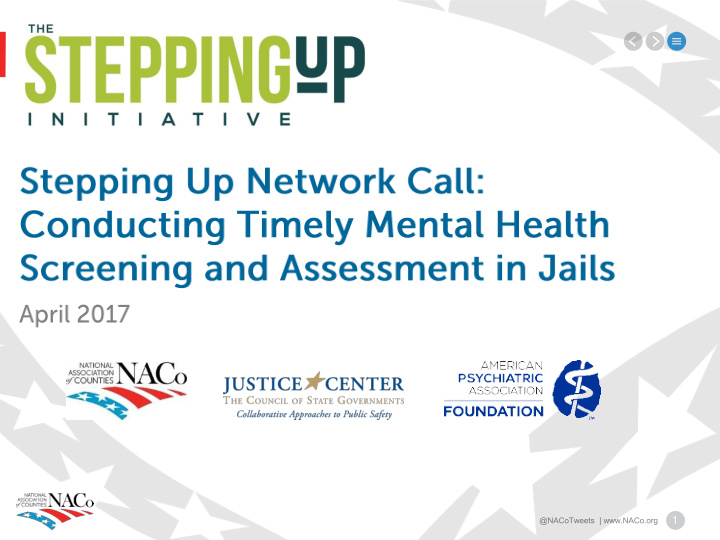



1
2
Where in the World is Stepping Up? American Psychiatric Association (San Diego, Calif.) 3
Upcoming Stepping Up TA Resources 4
Grants Available • • • • • • 5
Michael Schaefer, Ph.D., ABPP Assistant Commissioner - Forensics Virginia Dept. Behavioral Health and Developmental Services 6
MENTAL HEALTH SCREENING IN LOCAL & REGIONAL JAILS April 12, 2017 Michael Schaefer, Ph.D. Assistant Commissioner - Forensics Virginia Department of Behavioral Health and Developmental Services
Role of Mental Health Screening in Jail • Mental Health Screening is included in most best practice guidelines for jails • Provides a cost effective means to identify inmates in need of mental health services – Use correctional officers to perform initial screen – For those who score (+) follow-up assessment by nursing/mental health staff – For those in need of psychiatric services, follow-up assessment by psychiatrist/ psychiatric nurse practitioner • Mental Health Screening conducted by trained correctional officers has been found to reliably identify inmates in need of further assessment • Some studies have found that without the use of standardized screening tools some jails fail to identify up to 67% of inmates with serious mental illness Slide 8
Screening Tools • There are a variety of screening tools which have been developed for the purpose of identifying inmates in need of mental health services • Only six have been subjected to replication studies – Brief Jail Mental Health Screen (BJMHS) – Correctional Mental Health Screen for Men (CMHS-M) – Correctional Mental Health Screen for Women (CMHS-W) – England Mental Health Screen (EMHS) – Jail Screening Assessment Tool (JSAT) – Referral Decision Scale (RDS) • Each has demonstrated sensitivity (rate at which it identifies “true positives”) and specificity (rate at which it identifies “true negatives”) rate • Goal is to balance true positive vs. false positive and to minimize false negative Slide 9
Screening Tools • If false positive rate is too high then have to use scarce resources on individuals who really don’t need services • If false negative rate is too high then individuals in need of assessment/ services are not properly identified. Risk of psychiatric decompensation Slide 10
Screening Tools – Strengths & Limitations • BJMHS developed to address limitations of the RDS, therefore most do not recommend the use of the RDS • BJMHS, CMHS – M, CMHS-W, and EMHS are brief (administration time of 5 minutes or less) and can be administered by either health or correctional staff • BJMHS accurately identifies males with mental illness although it is less accurate in identifying females with mental illness • JSAT is to be completed by nursing or psychology staff and requires 20-30 minutes to administer. Many jails do not have nursing staff/psychology staff readily available at all times thus creating barriers to use • BJMHS – 74% accurate with males & 55% accurate with females • CMHS-M – 75.5% accurate; CMHS-W – 75% accurate Slide 11
Screening Tools • Virginia has long encouraged jails to utilize the BJMHS • Byrne Justice Assistance Grants (federal criminal justice grants) have been awarded to localities to standardize the use of the BJMHS in jails • Per the 2016 Mental Illness in Jails report from the State Compensation Board – 51 of 59 jails reported they conduct mental health screening for new inmates (although it is unclear what percentage of inmates are actually screened). • 50% of Virginia jails reported using the BJMHS • Justice Involved Transformation Team and the Center for Behavioral Health & Justice – Center Advisory Group recommended that Virginia develop standard screening practices Slide 12
Recommendations Regarding Screening • Utilizing standardized screening tool is best practice standard • DBHDS currently encourages the use of the BJMHS for men and CMHS-W for women • Department of Criminal Justice Services required agreement to utilize standardized screening tool as part of pilot project grant application. • During the 2017 General Assembly Session, Budget Item 70 #1c requires, “Whenever a person is admitted to a local or regional correctional facility, the staff of the facility shall screen such person for mental illness using a scientifically validated instrument. The Commissioner of DBHDS shall designate the instrument to be used for the screenings and such instrument shall be capable of being administered by an employee of th elocal or regional correctional facility, other than a health care provider, provided that such employee is trained in the administration of such instrument”. Slide 13
Cost to Implement Uniform Screening in All Jails • BJMHS & CMHS-M/W are both within the public domain and are “free” to use • Best practice standards require that correctional officers be trained in utilizing the recommended tool • Training can be accomplished in 2 hours • DBHDS is developing the training and will use a train the trainer model so that jails can eventually train their own staff • Will also offer web-based training to minimize cost to the localities. Slide 14
Sarah Wurzburg Grantee Technical Assistance Manager Council of State Governments Justice Center Michael Schaefer, Ph.D., ABPP Bruce Barnard Assistant Commissioner Consultant, Reentry Program Forensic Services Champaign County, Ill. Virginia Dept. Behavioral Health and Disability Services Mike Brouwer, M.Ed. Reentry Director Douglas County Sheriff's Office Douglas County, Kan. 15
Poll Questions 16
Next Steps 17
18
Recommend
More recommend